
Travelers all over the world come to South Dakota to view the United States monument, Mt. Rushmore, four Presidential faces “carved” out of large granite formations in the Black Hills. Mt. Rushmore is just one of the myriad area features; this part of the state boasts rich history, fascinating geology, unique art galleries, and clever tourist attractions.
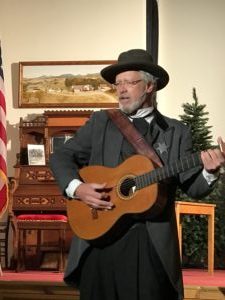
Day 1 of the trip took us to the High Plains Western Heritage Center near Spearfish, where an excellent video gives an overview of a five-state region: North Dakota, South Dakota, Montana, Wyoming, and Nebraska. The museum was started by Harry Blair and Edgar Gardner, two ranchers who wanted to honor five categories of pioneering: agriculture, mining, transportation, logging, and Native American Lore. Attractive displays are staged throughout the museum which is filled with artifacts from the past such as a stage coach, buggies, antique farm equipment, tools for blacksmithing, and rodeo artifacts. Another museum feature is an impersonator who shares the story of the early sheriff of Deadwood, South Dakota who entertained us with ballads that told the early history of the town. After lunch, we headed to Lead, South Dakota where we toured the Lead Opera House. The Opera House was built by the Homestake Mining Company for the benefit of the town’s gold miners and contains a billiard room, swimming pool, bowling alley, opera theater, and lounges. The Lead gold mine was the largest gold mine in the western hemisphere in the early 1900s. Sara Carlson, executive director of the opera house, demonstrated the excellent theater acoustics by singing an aria which was easily heard throughout the opera house. Sadly, a fire nearly destroyed the theater portion of the building in 1984; however, Carlson explained that funds are enabling restoration and structural improvements. Today, the Homestake Opera House is a community center offering musicals, adult comedy plays, and children’s shows. Following the opera house tour, we headed to the Homestake Visitor Center where we could view the expansiveness of the closed gold mine and learn that it is now home to a deep underground physics laboratory testing nutrinas and how they travel. Scientists from around the world visit the underground laboratory.
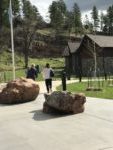
Day 2 took us to Custer State Park via Iron Mt. Road where we traveled through tiny tunnels which had been blasted from the granite and saw “pigtail bridges” made of intertwined wood. At Custer State Park, we photographed buffalo which were grazing outside the visitor center. After viewing a film about the history and wildlife in the park, we traveled the “wildlife loop,” seeing animals in their natural habitat: coyote, prairie dogs, burros, deer, and pronghorn. A tasty lunch was consumed at Buglin’ Bull in Custer (some local dishes like buffalo burgers and elk stew are available) and then we departed for a guided tour at Crazy Horse, a memorial being built to preserve the culture, traditions, and living heritage of the North American Indians. The image of Crazy Horse, a revered Lakota warrior is being blasted from the granite and we viewed its progress–a large noble head with an outstretched arm.
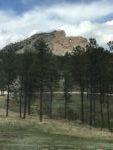
The sculpture was started by Polish-American Korczak Ziolkowsky and following Ziolkowsky’s death, is being continued by a board of directors. When completed, the sculpture of Crazy Horse atop his horse, will stand some 563 feet high. The Ziolkowsky family provides tours of a museum at the base of the memorial which showcases family pictures and artifacts.
We chose to view Mt. Rushmore on Day 3 and were excited to see the four large heads of Presidents Washington, Jefferson, Roosevelt, and Lincoln. Their faces were sculpted by Gutzon Borglum and his staff of former gold miners who used dynamite to remove sections of granite. A walkway decorated with U.S. state flags allows visitors to get closer to Mt. Rushmore. The monument represents the country’s democratic-republican form of government and each President was selected as representative of a significant historical time: Washington was the founder of our government; Jefferson authored the Declaration of Independence and spearheaded the purchase of the Louisiana Territory; Roosevelt led the country into the 20th century and was known for constructing the Pananma Canal and abolishing corporate monopolies; Lincoln restored the country after the Civil War and ended slavery.

Viewers can check-out listening wands which narrate interesting facts about the monument as they stop at trail markers along monument pathways. We enjoyed a nice lunch at Tilly’s, a restaurant featuring a community table where visitors can join up with local diners. Following our lunch, we toured the Journey Museum and Learning Center in Rapid City. Interactive exhibits take visitors through time from the creation of the universe to the present. At this museum we learned more about the geologic structure and history of the Black Hills. Geologists refer to the Black Hills as a domed uplift heavily affected by surface erosion. Easily visible are organized series of rock layers that were pushed up from below and then weathered. The term “Black Hills” also refers to its appearance as dark-colored due to the dense Ponderosa pine trees atop the various rock formations. Plan to spend a lot of drive time winding around the majestic hills.
On Day 4, we toured the Mammoth Site of Hot Springs, a structure built over an ancient sink hole where remains of mammoth and short-faced bears are partially unearthed. Guides lead groups along walkways that hover over the sink hole so viewers can see the ancient Ice Age skeletons up close. This site is unique because it is a working excavation site; an archaeologist explains how the skeletons are unearthed and preserved.
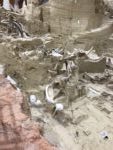
The animals became trapped some 26,000 years ago by searching for water and falling into the sink hole, unable to escape. After lunch at Wooly’s, we toured the Black Hills Institute located in downtown Hill City. The institute was developed by Neal Larson and Bob Farrar who have a passion for paleontology, geology, and mineralogy. The collection displayed here is impressive and includes “Stan, T-Rex.”
You shouldn’t visit the Black Hills without taking in the “Badlands.” These Pierre shale formations are the result of a shallow sea that covered this part of the Great Plains some 75 million years ago and look like ghostly lunar mountains. The sedimentary rock has revealed numerous kinds of fossilized animals. Hiking trails wind around dozens of formations and showcase prairie dogs, ferrets, and big horn sheep.
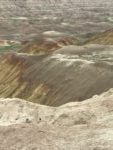
A few miles north of the Bad Lands, is Wall Drug, a commercial center that began as a pharmacy offering free ice water to travelers. Today, Wall Drug is a series of shops featuring western-style gifts, clothing, pottery, jewelry, and paintings. There are several western-style life size dioramas throughout the shops.
Farther east from the Badlands, in the town of Mitchell, South Dakota, visitors can tour the famous corn palace.
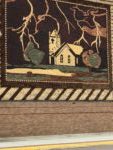
The Corn Palace features large murals, carefully designed and constructed from different colors of corn ears. Each August, area folk artists design and create new murals based on a selected theme. Even the pillars inside the corn palace reflect a corn mosaic design.
You’ll be glad you visit this unique region of the United States. Its majestic geography, history, and culture will wow you!